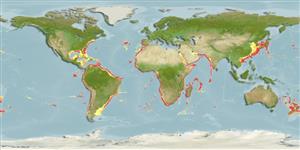Lớp phụ Cá sụn (cá mập và cá đuối) (sharks and rays) >
Squaliformes (Sleeper and dogfish sharks) >
Etmopteridae (Lantern sharks)
Etymology: Etmopterus: Greek, ethmos, -ou = sieve or ethmoides bone + Greek, pteron = wing, fin (Ref. 45335).
More on author: Lowe.
Environment: milieu / climate zone / depth range / distribution range
Sinh thái học
Biển Tầng đáy biển sâu; Ở đại duơng, biển (Ref. 51243); Mức độ sâu 0 - 1120 m (Ref. 106604), usually 400 - 700 m (Ref. 36731). Deep-water; 45°N - 55°S, 98°W - 171°W
Western Atlantic: northern Gulf of Mexico and southern Brazil to Argentina (Ref. 247, 6871); one specimen collected off the Guianas (Ref. 13608). Eastern Atlantic: Portugal to Namibia (Ref. 247, 127434). Also in oceanic waters between Argentina and South Africa (Ref. 247). Western Indian Ocean: South Africa, and Arabian Sea (Ref.85183). Western Pacific: Australia (Ref. 6871), New Zealand (Ref. 26346), and Japan (Ref. 247). Southeast Pacific: Amber Seamount, Nasca and Sala-y-Gomez.
Length at first maturity / Bộ gần gũi / Khối lượng (Trọng lượng) / Age
Maturity: Lm 42.5, range 38 - 47 cm
Max length : 50.0 cm TL con đực/không giới tính; (Ref. 36731)
Các tia vây lưng cứng (tổng cộng) : 2; Tia cứng vây hậu môn: 0. Bladelike unicuspidate teeth in lower jaw and teeth with cusps and cusplets in upper jaw, relatively short snout, low, truncated denticles (Ref. 247). Blackish brown dorsally, with an obscure broad black mark running above, in front and behind pelvic fins (Ref. 247).
Found on or near the bottom of continental and insular slopes at depths from 275 to 1,000 m (possibly to 2,000 m); also oceanic in the south Atlantic from the surface to 710 m (Ref. 6871), possibly as deep as 1998 m (Ref. 58302). Feeds on fish eggs, lanternfish, squid, and other small dogfish (Ref. 5578). Ovoviviparous (Ref. 205). Utilized dried salted for human consumption and for fishmeal (Ref. 247).
Life cycle and mating behavior
Chín muồi sinh dục | Sự tái sinh sản | Đẻ trứng | Các trứng | Sự sinh sản | Ấu trùng
Ovoviviparous (Ref. 247). Distinct pairing with embrace (Ref. 205).
Compagno, L.J.V., 1984. FAO Species Catalogue. Vol. 4. Sharks of the world. An annotated and illustrated catalogue of shark species known to date. Part 1 - Hexanchiformes to Lamniformes. FAO Fish. Synop. 125(4/1):1-249. Rome, FAO. (Ref. 247)
IUCN Red List Status (Ref. 130435: Version 2024-1)
Threat to humans
Harmless
Human uses
Các nghề cá: buôn bán nhỏ
Các công cụ
Special reports
Download XML
Các nguồn internet
Estimates based on models
Preferred temperature (Ref.
123201): 5.3 - 13.6, mean 8.9 °C (based on 409 cells).
Phylogenetic diversity index (Ref.
82804): PD
50 = 0.5000 [Uniqueness, from 0.5 = low to 2.0 = high].
Bayesian length-weight: a=0.00347 (0.00226 - 0.00532), b=3.05 (2.92 - 3.18), in cm total length, based on LWR estimates for this species & Genus-body shape (Ref.
93245).
Mức dinh dưỡng (Ref.
69278): 4.2 ±0.4 se; based on diet studies.
Thích nghi nhanh (Ref.
120179): thấp, thời gian nhân đôi của chủng quần tối thiểu là 4.5 - 14 năm (Fec assumed to be <100).
Fishing Vulnerability (Ref.
59153): Moderate vulnerability (40 of 100).
Nutrients (Ref.
124155): Calcium = 11 [2, 59] mg/100g; Iron = 0.361 [0.083, 1.174] mg/100g; Protein = 19.3 [16.7, 21.6] %; Omega3 = 0.335 [0.121, 1.064] g/100g; Selenium = 12.6 [3.9, 37.7] μg/100g; VitaminA = 19 [4, 88] μg/100g; Zinc = 0.336 [0.161, 0.660] mg/100g (wet weight);
